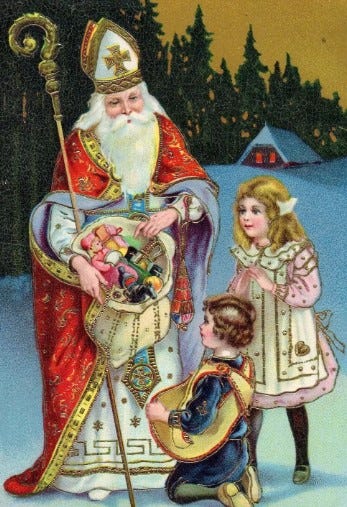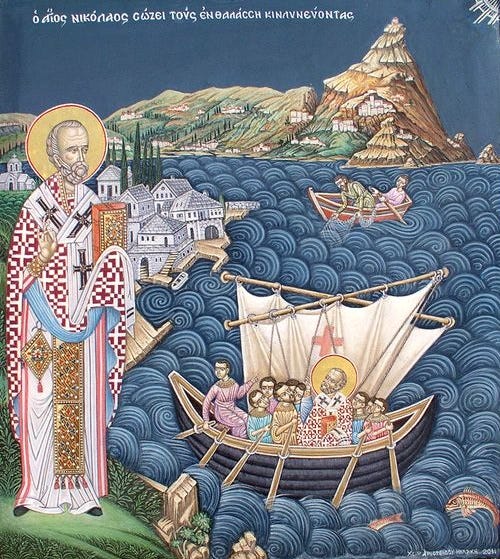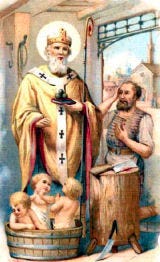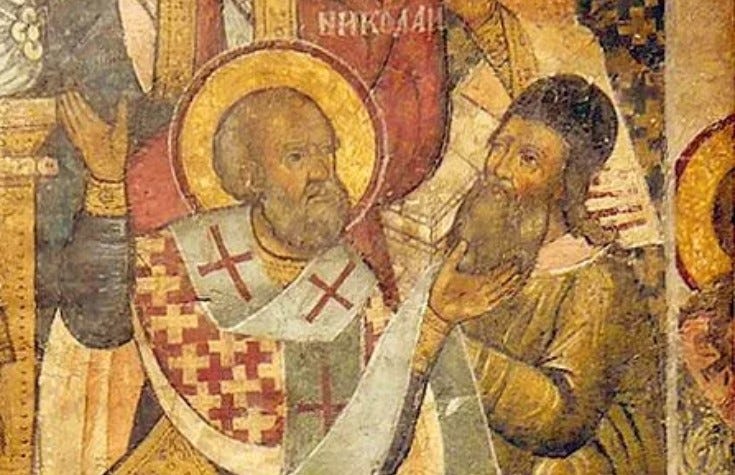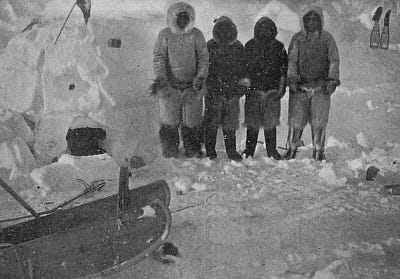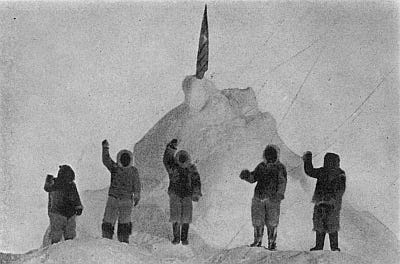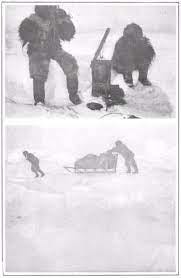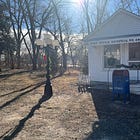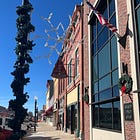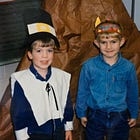It's December 26th, 2024 and Nicholas is exhausted. He has been at the helm of The North Pole, Inc. for 1699 years and the world is changing. What had started out as a small hobby of whittling wooden trains and gifting them to the neighborhood children in his hometown of Patara in modern-day Turkey, has since become the world's largest and logistically complicated charitable gifting and expedited package delivery service. The 2025 Christmas would mark the company's 1700th year in operation, and Nicholas was beginning to wonder if the time had come to put forth a serious succession plan. Frankly, the old ways of doing things didn't seem to be working anymore, which for a nostalgic man like Nicholas, created some serious questions about whether or not he was still the right man to lead his l,872 employees and herd of 8 (sometimes 9) reindeer. Did a business model based entirely on gift giving in lieu of profits even make sense anymore?
•••
Becoming Saint Nick
Nicholas of Myra was born on March 15th, 270 AD to a very religious family. His parents, Theophanes and Nonna, were active in the local church of Patara and encouraged Nicholas to get involved in the community at a young age. Nicholas's uncle was the Bishop of Myra —a city nearby. His parents were very wealthy, and the family would join Nicholas’s uncle annually in distributing gifts to the less fortunate throughout the region of Lycia. This act of delivering gifts— particularly to children— made a huge impression on young Nicholas.
"At the time, the whole concept of 'Christmas' was a relatively new one. The church hadn't been around for that many generations, and a lot of the holidays and traditions were still being figured out. It was my uncle that first had the idea of going around and giving gifts to children as a simple way of celebrating the birth of Jesus, the idea being that if they got a present it would help them see the birth of Jesus as a gift as well. I'm not sure how many kids really understood that association, but they sure liked getting presents. And it made me thrilled to see their smiles. It became my favorite thing to do each year."
-Nicholas, CEO, The North Pole, Inc.
Nicholas began planning ahead. He would study which gifts the kids responded to most favorably and began crafting a surplus as soon as one Christmas ended to prepare for the next one. Before long, making toys was a year-round hobby, though it was still just a hobby. But making and distributing toys wasn't the only activity of Nicholas's that soon grew into a passion, he became fascinated with magic. His uncle gave Nicholas his first magic set during one of the annual toy distributions, and Nicholas became infatuated with it. He would put pieces of straw through drachma coins and fascinate his family with simple mentalism tricks that made it appear he knew what they had been doing when no one was watching. His magic tricks grew more and more elaborate as he practiced, and soon rumors spread that Nicholas possessed clairvoyance and supernatural abilities.
"Ho, ho, ho. It was great fun. People will believe anything if they really want to. Deep down, we all want to believe that magic is real. If you can tap into that, you can get away with just about anything. That is, as long as people think the magic isn't harmful. Once you start losing trust, and people don't want to believe anymore, then the whole thing unravels."
-Nicholas, CEO, The North Pole, Inc.
With this principle of using magic for the common good, Nicholas's reputation went from jovial to transcendent. Rumors started to spread. Residents of Lycia claimed that he could calm a storm at sea and had chopped down a demon-possessed tree.
Artists depicted Nicholas raising three children from the dead after they had been murdered by a butcher. Allegedly the butcher had pickled the children in brine with the intention of selling them as pork. Pork was hard to come by.
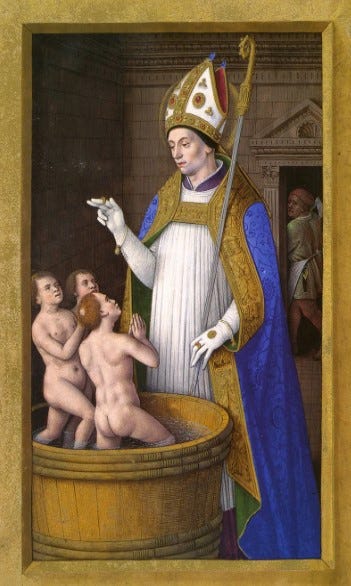
On another occasion, townspeople claimed that Nicholas had rescued three girls from a future as prostitutes. The story went that for three consecutive nights, Nicholas deposited a sack of gold down their chimney. The idea was for their father to use the gold as a dowry and marry the girls off instead. No one ever saw Nicholas in the act, but his reputation for stealth and generosity made him the prime suspect. Nicholas never admitted to anything.
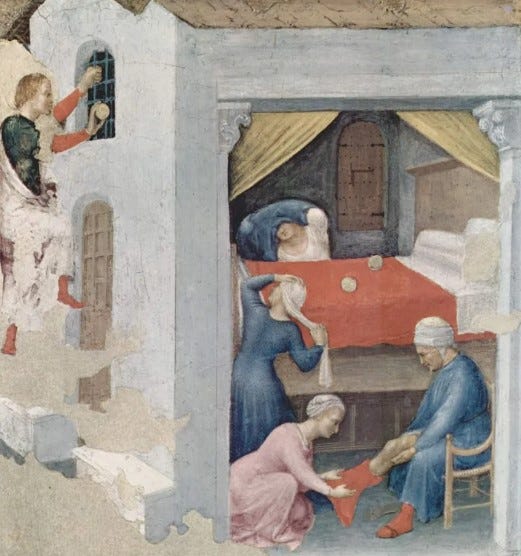
The rumors troubled Nicholas and made it harder and harder for him to efficiently get through town without being bombarded with requests for gifts and magic tricks. As a result, he became a recluse. Nicholas moved outside of the community to a remote area of Mesopotamia, which quelled some of the town gossip and gave him ample time to refine his toymaking craft.1
•••
Forming The North Pole, Inc.
Nicholas expanded his toy distribution service to the areas surrounding his new home. Around 300 AD, at the age of 30, Nicholas hired his first employee— a small, paunchy outcast that Nicholas nicknamed 'Crumpit.' His real name was Larry.
"I had frankly bitten off more than I could chew. Each year more children would hear about the gift giving and would send me a letter asking to be included. I've always had a problem telling anyone 'no’ to anything, so I looked for help. I found Crumpit begging on a street corner. He had an odd look to him, some sort of disability that had stunted his growth and made him unemployable at any of the markets throughout Lycia. I took pity on him, and taught him how to whittle in exchange for room and board. After a while, it seemed as though Crumpit was running the whole toy making process himself and all I was doing was giving the gifts away once each year."
-Nicholas, CEO, The North Pole, Inc.
Without Crumpit, Nicholas likely would have remained simply a jolly old man giving away toys to boys and girls in ancient Turkey— not the international celebrity and pop culture icon that he is today. However it was a brush with church politics that ultimately led Nicholas to pursing this charitable career path full-time.
“I was working as the Bishop of Turkey at the time after my uncle put in a good word with the church leaders. I was excited about the gig, but I was really doing it out of an obligation to my uncle. He never married since priests spent so much time doing other things, though he could have since the clerical celibacy didn't get established until the 12th century. But still, I was the closest thing he had to a son. So I took the job and I hated it."
-Nicholas, CEO, The North Pole, Inc.
In 325 AD, a church council was called at the city of Nicea by Emperor Constantine. Constantine had used the Christian religion as a political tactic to unite his empire. Disputes had arisen throughout the church regarding the nature of Jesus, which threatened Constantine’s unification strategy. He sought to who put an end to the divisions and shore up his approval ratings. And like any good politician, Constantine used the most effective means available: long, tedious debates. As the Bishop of Turkey, Nicholas was required to attend, but found the proceedings cumbersome and frustrating, at one point slapping a fellow participant.2
“There were over 1000 people there, and everyone seemed to have an opinion. There was grandstanding, hair-splitting, and hell-raising. We were stuck in this stuffy palace for over a month and a half, and all I could do was think about how none of the kids I gave toys to really gave a shit about any of this. Don't get me wrong, I think the Council had a lot of good things come out of it, but by the end of it, I had had it with church politics."
-Nicholas, CEO, The North Pole, Inc.
The main outcome of the Council of Nicea was the Nicene Creed which formalized the canonical beliefs of the Christian Church for the first time. Nicholas signed the creed, but shortly after left his post of Bishop. He had different plans.
"The Council was crucial for the Church, but I had seen how the sausage was made, and frankly, it had spoiled my appetite for sausage. When I got back from Nicea, Crumpit presented me with an elaborate business prospectus he had worked up regarding how to take the toy manufacturing to the next level. I was at a crossroads, and sensed that if I didn't take Crumpit's ideas seriously, he may leave and start out on his own. So I told him, 'Fuck it. Let's do this.’”
-Nicholas, CEO, The North Pole, Inc.
•••
Headquarters Relocation
When Nicholas's parents passed away, he was the sole heir to their vast fortune. As a bishop, he had little need for the inheritance and instead invested the entirety of it in various speculative enterprises. He was an early investor in wheel technology— though he always preferred the simple elegance of the sleigh, "fewer moving parts" he'd always say— and purchased numerous tracts of land, particularly in Western Europe and Scandinavia. He began to vacation frequently in Spain, and would spend much of his time in the country when away from Turkey. But it was a failed investment in an uninhabitable wasteland that proved to be the one that would change his fortune forever.
"When I first purchased the north pole, I thought that the return on investment would occur from the exportation of ice. At the time, no one had thought of mechanical refrigeration, so I had this crazy idea that we could harvest ice from the glaciers, and then ship it all throughout warm climates like India or Africa so wealthy aristocrats could chill their beverages. The idea was ahead of its time. The transportation of glacier ice proved to be too costly. The concept caught hold later on after I had already divested of all my infrastructure and I was just left with a useless chunk of frozen tundra."
-Nicholas, CEO, The North Pole, Inc.
Nicholas had tried to sell off this north pole property numerous times unsuccessfully, but the location became a centerpiece of Crumpit's expansion plans. By moving to the north pole, Nicholas and Crumpit would have enough real estate to expand their operation indefinitely and be logistically located to be equidistant to nearly every location above the equator. At the time, colonialization had yet to move much further south, so the Christmas celebrating nations were largely concentrated in Europe. The plan was too large for two people, but Crumpit had considered that as well. From his time on the streets, Crumpit had befriended innumerable deformed beggars in need of stable wages. Given their living situations, these vagabonds were more than willing to relocate for the promise of room and board. Nicholas loved these odd employees. He found them cheerful and hardworking, more than willing to labor around the clock in appreciation for their jobs. Nicholas could never remember any of their names so, like ‘Crumpit,’ he came up with festive nicknames. These monikers became so widely adopted throughout the north pole that hardly anyone used their Christian names. Many of these workers had been addicted to opium or alcohol prior to their employment, which could make their behavior erratic and childlike— though this characteristic proved to be helpful in the development of several new product lines.
With the workforce riddle solved, Nicholas and Crumpit turned their attention to distribution. From the failed ice harvesting exploit, Nicholas knew that moving large quantities of material from the north pole was expensive and difficult. Ships had trouble navigating the glaciers and industrial airplanes had yet to be invented. The harsh climate severely limited their options.
"We considered your traditional cattle and pack animals, but none could survive in the temperatures of the north pole. We tried, it’s best not to talk about what happened.”
-Nicholas, CEO, The North Pole, Inc.
The relocation began without any plans for toy transportation in place. Nicholas considered that he might have to take a Christmas or two off in order to find a solution, but providence provided an answer when a pack of wild reindeer were spotted roaming through their construction sites. An environmental impact study took place and halted construction for three months while Crumpit and Chestnut— a former zoologist that had found himself homeless after getting mauled by an orangutan and addicted to painkillers during his recovery— studied the movements of the reindeer herd. The factory site map was redrawn to accommodate the reindeer habitats, but as construction resumed on Mechanical Toy Warehouse #3, the reindeer only encroached further.
Chestnut had an idea.
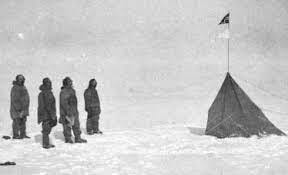
"Everyone wants to know how we domesticated wild reindeer and taught them to fly, but frankly I get tired of the question. If you explain magic, it ceases to be magical, and I'd rather not have that. Penn and Teller don't stand up after their performance at the Rio Casino and explain how they perform each of their tricks, and if they did, they wouldn’t have a paying audience for very long."
-Nicholas, CEO, The North Pole, Inc.
Nicholas would give a similar answer whenever pressed about any of the magical elements of his craft— “trade secrets” he'd say. This included explanations regarding how he visits every house in a single night, how to enter homes without chimneys, and how he has avoided being diagnosed with Type II diabetes after a thousand year diet of nothing but milk and sugar cookies.
•••
Financial Woes
Like any start-up, Nicholas anticipated running at a financial deficit in the company's early years, but after several centuries, The North Pole, Inc. had still yet to turn a profit. And the fortune Nicholas had inherited from his parents was dwindling.
"It turns out that a business model based on giving away your product for free isn’t sustainable in the long run."
-Nicholas, CEO, The North Pole, Inc.
It was this realization that truly transformed The North Pole, Inc.
"People have no idea how we stay financially solvent, and I like it that way. It's part of the mystery. But truth be told, it's simple really. All we do is sell licensing."
-Nicholas, CEO, The North Pole, Inc.
It really is that simple, yet The North Pole, Inc. has became one of the largest corporations in the world through simple, yet incredibly effective, marketing and branding. The genius came from a ball bearing assembly line supervisor whom Nicholas called Cauliflower.
"Nicholas would often come into our plants to inspect the process. He was always in a good mood and had the weirdest laugh. We started making fun of him for it. It was in the break room over lunch where one of the workers was giving an impression of his now famous ‘ho, ho, ho,' that it dawned on me. This should be a catchphrase."
-Cauliflower, CMO, The North Pole, Inc.
Cauliflower pitched the idea to Crumpit, who had since been promoted to the company’s very first Chief Operations Officer. But Crumpit was skeptical. A catch phrase would only do so much, what Nicholas really needed was a complete rebranding. Crumpit promoted Cauliflower to Chief Marketing Officer and tasked him with overhauling the image of Nicholas. It was through this effort that Saint Nicholas was transformed into Santa Claus.
"The exact process of how Nicholas reached sainthood isn't clear, but it seemed that it mostly stemmed from his work during the Council of Nicea, even though Nicholas himself always loathed that time. But as a result, some started to refer to him as 'Sinterklaas.' We wanted to retain the honorific title, but make it a little more palatable to the non Roman-Catholic audience. So we worked with a few different advertising agencies and landed on 'Santa Claus.'"
-Cauliflower, CMO, The North Pole, Inc.
With a new name and catchphrase, Cauliflower also thought Nicholas needed a makeover. The signature look of a red suit with fluffy white trim was based off an old jacket Nicholas had been given by a girlfriend he met while in Spain during the offseason. The coat was meant to resemble the jacket of a matador, but Cauliflower removed the sequence and elongated the waistline, combined the outfit with the work boots Nicholas wore while tending the reindeer stables, and came up with the idea for the hat after one of the elves got drunk at an after-Christmas party and put a stocking on his head. Santa later married that young Spaniard, but few know that Mrs. Claus's biggest contribution was the simple purchase of a red coat for her boyfriend. Cauliflower began pitching the new ‘Santa Claus’ to established corporations and found a willing partner in the Coca-Cola Beverage Company to use the image in their winter advertisements. The ads proved enormously successful. To date, the licensing deal with Coca-Cola remains one of the largest annual sources of revenue for The North Pole, Inc. and is the second most lucrative licensing deal of all-time, trailing only the Air Jordan brand partnership between Michael Jordan and Nike.

"Look, 'believing in Santa' and 'Christmas cheer' are all fine and good, but those don't pay the bills. Cash does. People don't like how commercial Christmas has become, but what they don't realize is that Santa could never have stayed afloat any other way. Unless you want to start paying for elf wages, reindeer food, and toy manufacturing costs, Christmas is going to have to be commercial. There just isn't any other way."
-Cauliflower, CMO, The North Pole, Inc.
But Cauliflower and his team weren’t done working Christmas marketing miracles. Shortly after the success of the complete Santa re-brand, they hit another marketing home run in the form of a beast of burden with a genetic mutation.
https://en.wikipedia.org/wiki/Saint_Nicholas
https://www.kxnet.com/news/top-stories/who-was-saint-nicholas-the-historical-background-of-a-holiday-icon/




